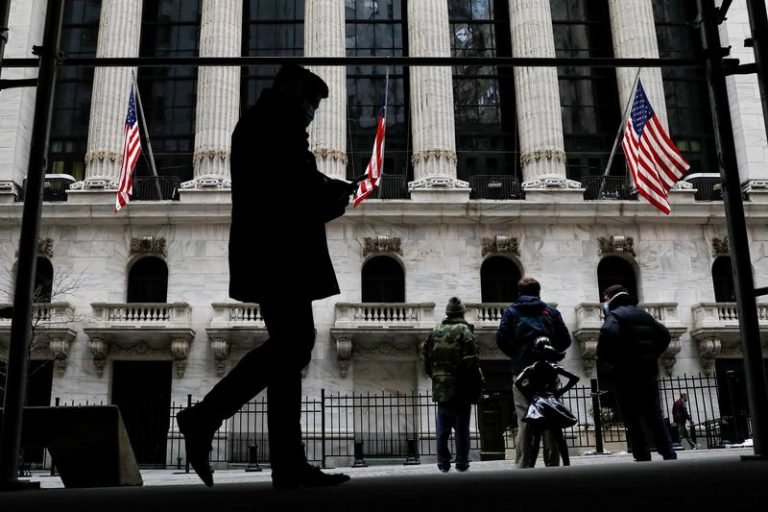
LONDON (Reuters) – With the potential of an inflation-led market sell-off on their minds, many bond buyers are retreating for shelter to the unlikely haven of junk bonds, a sector sometimes thought-about one of many riskiest.
Bonds from firms with scores under BBB-minus are thought-about much less secure, therefore the market time period “junk” or “high-yield”. They provide higher yields to compensate for the upper default charge in contrast with “funding grade” firms.
But with buyers believing the chief threat for bond markets in the meanwhile is the tightening of financial coverage, these larger yields are seen as a buffer slightly than a warning sign.
With the USA recording inflation above expectations not too long ago, buyers fret that the Federal Reserve might start “tapering”, or unwinding, its money-printing.
“Mounted-rate funding grade bonds are very costly and really tight and could be extraordinarily delicate to any concern from the markets on larger charges,” stated Cosimo Marasciulo, head of funding absolute returns at Amundi, Europe’s largest asset supervisor. “There’s completely no unfold safety there,” he added, referring to the yield premiums the bonds carry versus authorities debt.
Certainly, Markit’s iBoxx index suite reveals U.S. and European high-grade spreads on the tightest ever towards authorities debt benchmarks. They tightened aggressively over the past 10 months after the Fed added them to its asset buy scheme and the European Central Financial institution ramped up shopping for.
U.S. investment-grade bonds presently pay a 103 basis-point yield premium over Treasuries, a document low, in accordance with Markit’s iBoxx index.
Junk bond funds, in the meantime, have loved 9 straight weeks of funding inflows, in accordance with fund tracker EPFR, which additionally highlights six consecutive weeks of flows to devoted change traded funds (ETFs).
The sector has generated year-to-date returns of greater than 2%, whereas investment-grade debtholders have endured a 3.6% loss, ICE BofA indexes present. (Graphic: Junk vs IG returns, )
DURATION DIFFERENCE
Eight years in the past, then Fed boss Ben Bernanke hinted at decreasing, or tapering, the asset purchases first instituted within the aftermath of the 2008 monetary disaster. The next savage sell-off was dubbed the “taper tantrum”.
Now, U.S. President Joe Biden’s $1.9 trillion spending plan and up to date strong financial information have gotten markets betting the Fed will begin scaling again asset purchases from early-2022.
The 2013 tantrum noticed junk bonds endure greater than high-rated friends. This time the axe might fall extra closely on investment-grade debt for 2 causes – tighter spreads and better period.
Period, a perform of how lengthy collectors take to recoup their funding, is seen as a measure of how delicate a bond’s value is to rate of interest threat.
The simple-money years allowed firms to challenge extra long-maturity debt, boosting the common period of U.S. investment-grade bonds to a near-record 7.7 years, versus 6.6 years in 2013.
Common junk debt period in the meantime is 3.34 years, Markit iBoxx indexes present. (Graphic: IG vs excessive yield period, )
“The massive cloud hanging over liquid markets is inflation-induced charge threat. We’re very targeted on charge volatility and the influence that has on bond markets, so we’re underweight longer period, fixed-rate investments,” stated Joseph Moroney, co-head of worldwide company credit score at personal fairness heavyweight Apollo.
Apollo is focusing as a substitute on floating charge securities akin to leveraged loans, the place yields enhance when charges rise. Moroney can also be transferring down the danger curve to single-B junk debt bonds, the place common 4.6% yields surpass the general junk index.
Junk bonds are in fact dangerous; scores company S&P International predicts default charges there at 7% by year-end, from 6.6% in December 2020. In distinction, defaults amongst funding grade companies are near-zero; even BBB-rated securities, the bottom funding grade rung, boast a historic 0.3% default charge.
Harry Richards, a fund supervisor for British cash supervisor Jupiter touts a “barbell” method – some authorities bond holdings “whereas intently exploring the riskier components of the market, which nonetheless have respectable carry and upside potential”.
Funding grade debt, he reckons, has absolutely priced any optimistic information so he has “been taking chips off the desk”.
Reporting by Abhinav Ramnarayan; Enhancing by Sujata Rao and and Alex Richardson